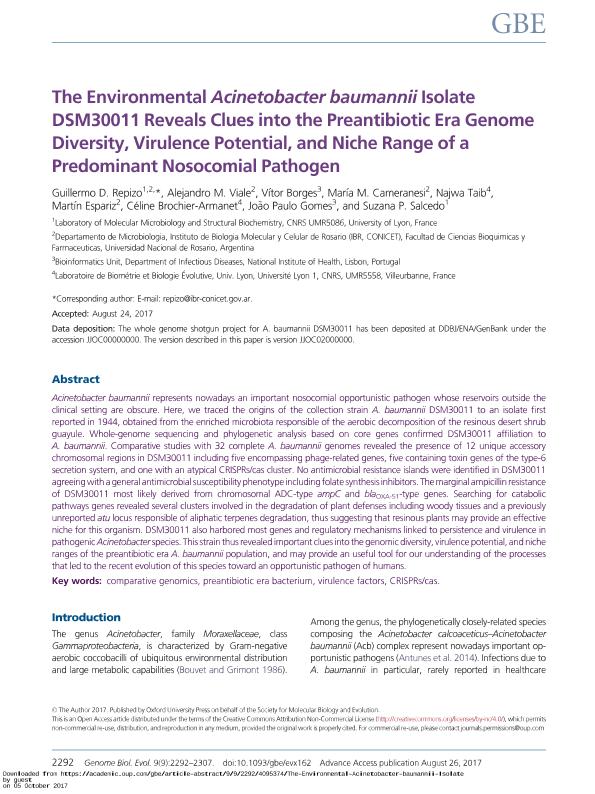Artículo
The environmental Acinetobacter baumannii isolate DSM30011 reveals clues into the preantibiotic era genome diversity, virulence potential, and niche range of a predominant nosocomial pathogen
Repizo, Guillermo Daniel ; Viale, Alejandro Miguel
; Viale, Alejandro Miguel ; Borges, Vitor; Cameranesi, María Marcela
; Borges, Vitor; Cameranesi, María Marcela ; Taib, Najwa; Espariz, Martin
; Taib, Najwa; Espariz, Martin ; Brochier Armanet, Celine; Gomes, João Paulo; Salcedo, Suzana P.
; Brochier Armanet, Celine; Gomes, João Paulo; Salcedo, Suzana P.
 ; Viale, Alejandro Miguel
; Viale, Alejandro Miguel ; Borges, Vitor; Cameranesi, María Marcela
; Borges, Vitor; Cameranesi, María Marcela ; Taib, Najwa; Espariz, Martin
; Taib, Najwa; Espariz, Martin ; Brochier Armanet, Celine; Gomes, João Paulo; Salcedo, Suzana P.
; Brochier Armanet, Celine; Gomes, João Paulo; Salcedo, Suzana P.
Fecha de publicación:
09/2017
Editorial:
Oxford University Press
Revista:
Genome Biology and Evolution
ISSN:
1759-6653
Idioma:
Inglés
Tipo de recurso:
Artículo publicado
Clasificación temática:
Resumen
Acinetobacter baumannii represents nowadays an important nosocomial opportunistic pathogen whose reservoirs outside the clinical setting are obscure. Here, we traced the origins of the collection strain A. Baumannii DSM30011 to an isolate first reported in 1944, obtained from the enriched microbiota responsible of the aerobic decomposition of the resinous desert shrub guayule. Whole-genome sequencing and phylogenetic analysis based on core genes confirmed DSM30011 affiliation to A. Baumannii. Comparative studies with 32 complete A. Baumannii genomes revealed the presence of 12 unique accessory chromosomal regions in DSM30011 including five encompassing phage-related genes, five containing toxin genes of the type-6 secretion system, and one with an atypical CRISPRs/cas cluster. No antimicrobial resistance islands were identified in DSM30011 agreeing with a general antimicrobial susceptibility phenotype including folate synthesis inhibitors. The marginal ampicillin resistance of DSM30011 most likely derived from chromosomal ADC-type ampC and blaOXA-51-type genes. Searching for catabolic pathways genes revealed several clusters involved in the degradation of plant defenses including woody tissues and a previously unreported atu locus responsible of aliphatic terpenes degradation, thus suggesting that resinous plants may provide an effective niche for this organism. DSM30011 also harbored most genes and regulatory mechanisms linked to persistence and virulence in pathogenic Acinetobacter species. This strain thus revealed important clues into the genomic diversity, virulence potential, and niche ranges of the preantibiotic era A. Baumannii population, and may provide an useful tool for our understanding of the processes that led to the recent evolution of this species toward an opportunistic pathogen of humans.
Archivos asociados
Licencia
Identificadores
Colecciones
Articulos(IBR)
Articulos de INST.DE BIOLOGIA MOLECULAR Y CELULAR DE ROSARIO
Articulos de INST.DE BIOLOGIA MOLECULAR Y CELULAR DE ROSARIO
Citación
Repizo, Guillermo Daniel; Viale, Alejandro Miguel; Borges, Vitor; Cameranesi, María Marcela; Taib, Najwa; et al.; The environmental Acinetobacter baumannii isolate DSM30011 reveals clues into the preantibiotic era genome diversity, virulence potential, and niche range of a predominant nosocomial pathogen; Oxford University Press; Genome Biology and Evolution; 9; 9; 9-2017; 2292-2307
Compartir
Altmétricas



